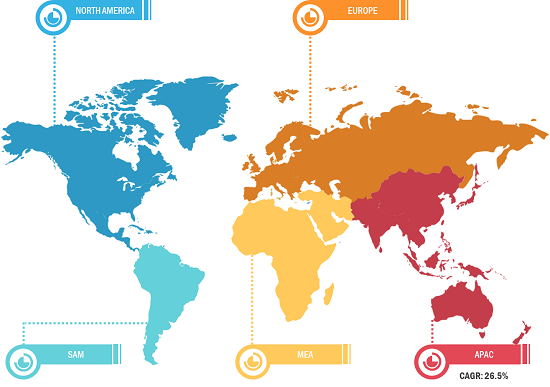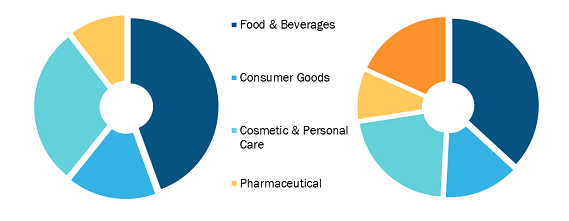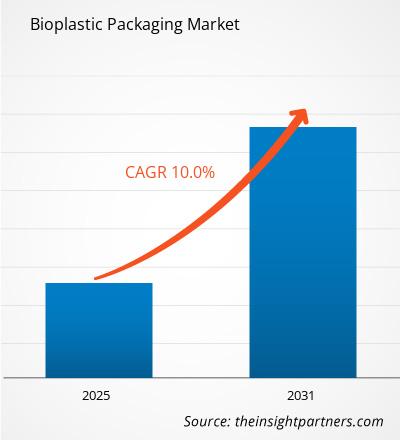Der Markt für Biokunststoffverpackungen wird bis 2031 voraussichtlich 47.991,9 Millionen US-Dollar erreichen 13.273,9 Millionen im Jahr 2022. Es wird erwartet, dass sie zwischen 2022 und 2031 mit einer jährlichen Wachstumsrate von 23,9 % wachsen wird.
Food & Getränke, Konsumgüter, Kosmetik & Körperpflegeprodukte und Pharmazeutika gehören zu den wichtigsten Endverbrauchern von Biokunststoffverpackungen. Kunststoffverpackungen werden in großem Umfang in verschiedenen Anwendungen eingesetzt, beispielsweise in der FMCG-, Lebensmittel- und Lebensmittelindustrie. Getränke, Pharmazeutika und Konsumgüter. Dieser zunehmende Einsatz von Kunststoff in verschiedenen Anwendungen ist für die zunehmende Plastikverschmutzung verantwortlich. Daher wird das Recycling und die Wiederverwendung von Kunststoff immer wichtiger für Innovation und Nachhaltigkeit. Darüber hinaus wird erwartet, dass herkömmlicher Kunststoff in Zukunft aufgrund knapper werdender Rohstoffquellen teurer wird. In den letzten Jahren hat Biokunststoff die Kunststoffindustrie durch Innovationen für mehr Ressourceneffizienz, Funktionalität und Nachhaltigkeit beeinflusst. Biokunststoffe spielen eine wichtige Rolle bei der Erhöhung der Recyclingziele und der Verbesserung der Abfallbewirtschaftung, indem sie Erdölressourcen durch erneuerbare Ressourcen ersetzen. Biokunststoffe werden aus erneuerbaren pflanzlichen Ressourcen hergestellt, die eine geringe Toxizität, eine bessere Recyclingfähigkeit und eine hohe biologische Abbaubarkeit bieten.
Im Jahr 2021 hatte Europa einen bedeutenden Anteil am globalen Markt für Biokunststoffverpackungen. Viele kleine und große Produktionsunternehmen sind in der Region vertreten. Die wachsende Präferenz der Verbraucher für organische und natürliche Polymere in Lebensmittelverpackungen wirkt sich positiv auf die Akzeptanzrate dieser nachhaltigen Verpackungslösungen in der Lebensmittel- und Lebensmittelindustrie aus. Getränkebranche in der Region. Neben dem Bewusstsein der Verbraucher fördert auch die Zunahme staatlicher Initiativen zur Förderung der Verwendung umweltfreundlicher Verpackungsprodukte in verschiedenen Ländern das Marktwachstum.
Strategische Einblicke
Auswirkungen der COVID-19-Pandemie auf den Markt für Biokunststoffverpackungen
Essen & Getränke, Konsumgüter, Kosmetik & Die Körperpflege- und Pharmaindustrie zählte vor dem Ausbruch der COVID-19-Pandemie zu den größten Nachfragemotoren im Markt für Biokunststoffverpackungen. Allerdings sah sich der Markt im ersten Quartal 2021 aufgrund von Betriebsschließungen, Rohstoffknappheit und Nichtverfügbarkeit von Arbeitskräften mit Hürden konfrontiert. Die COVID-19-Pandemie führte in den ersten Monaten des Jahres 2021 zu einer wirtschaftlichen Rezession, die zu einer finanziellen Belastung für Hersteller und Verbraucher führte. Die Lockerung der sozialen Beschränkungen und die Zunahme staatlicher Initiativen zur Ankurbelung ihrer Wirtschaft ermutigten die Industrien jedoch, ihre volle Leistungsfähigkeit auszuschöpfen. Dies trug schließlich zur Wiederbelebung des Marktes für Biokunststoffverpackungen Ende 2021 bei.
Marktaufschlüsselung für Biokunststoffverpackungen – nach Region, 2021 < /h3>
< /h3>Markteinblicke
Steigerung des Bewusstseins der Kunden für die schädlichen Auswirkungen herkömmlicher Kunststoffe
Derzeit ist Biokunststoff eine Alternative für nahezu jedes herkömmliche Kunststoffmaterial in vielfältigen Anwendungen. Biokunststoffe bieten innovative Lösungen mit verbesserten Eigenschaften sowie der besonderen Fähigkeit, Emissionen zu reduzieren und die gleichen Qualitäten und Funktionen wie herkömmlicher Kunststoff zu bieten. Diese biologisch abbaubaren Verpackungsmaterialien werden unter Verwendung nachwachsender Rohstoffe sowie fossiler Rohstoffe wie Celluloseester, PLA (Polymilchsäure), PHA (Polyhydroxyalkanoate), Stärkederivate und Copolyester wie PBS (Polybutylensuccinat) und PBAT (Polybutylenadipat) hergestellt. Co-Terephthalat). Viele Akteure der Branche tendieren dazu, biologisch abbaubare Verpackungslösungen anzubieten, da das Bewusstsein der Verbraucher für die Auswirkungen ihrer Konsumentscheidungen auf ihren Lebensstil und ihre Umwelt wächst und die Verbrauchernachfrage nach nachhaltigeren Produkten steigt. Der verstärkte Einsatz von Biokunststoff-Verpackungsmaterialien trägt zur Nachhaltigkeit bei und verringert die Umweltbelastung, die mit der Verwendung herkömmlicher Polymere verbunden ist. Daher kurbelt der Wandel der Verbrauchernachfrage aufgrund von Umweltbewusstsein, Verpackungsstil, Bequemlichkeit und nachhaltigen Produktionssystemen das Wachstum des globalen Marktes für Biokunststoffverpackungen an.
Kategorie-Einblicke< /span>
Basierend auf dem Produkt ist der Markt für Biokunststoffverpackungen in Stärkemischungen, Polymilchsäure, Polyethylenterephthalat, Polyhydroxyalkanoate und Polyethylen. Im Jahr 2021 hatte das Segment Stärkemischungen den größten Umsatzanteil.
Markt für Biokunststoffverpackungen nach Anwendung – 2021 und 2031

NatureWorks LLC, Arkema, Novamont SpA, BASF SE, Braskem, Corbion NV, Cardia Bioplastic Packaging, Evonik Industries AG, Koninklijke DSM NV und Dow Chemical Company gehören zu den wichtigsten Akteuren auf dem Markt. Diese Unternehmen verfügen über ein breites Produktportfolio, um ihre Kunden aus verschiedenen Industrie- und Entwicklungsländern zu bedienen. Sie konzentrieren sich auch auf die Entwicklung hochwertiger, innovativer Produkte, um die Anforderungen der Kunden zu erfüllen.
Report Spotlights
- Progressive Branchentrends auf dem Markt, um Spielern bei der Entwicklung effektiver langfristiger Strategien zu helfen
- Geschäftswachstumsstrategien von Unternehmen zur Sicherung des Wachstums in entwickelten und sich entwickelnden Märkten
- Quantitative Analyse der Marktgröße von Biokunststoffverpackungen von 2021 bis 2031
- Schätzung der weltweiten Nachfrage nach Biokunststoffverpackungen
- PEST-Analyse zur Veranschaulichung der Wirksamkeit von Käufern und Lieferanten, die in der Branche tätig sind
- Neueste Entwicklungen zum Verständnis des Wettbewerbsmarktszenarios
- Markttrends und -aussichten sowie Faktoren, die das Wachstum des Marktes für Biokunststoffverpackungen vorantreiben und bremsen
- Unterstützung im Entscheidungsprozess durch Hervorhebung von Marktstrategien, die kommerzielle Interessen untermauern
- Die Größe des Marktes für Biokunststoffverpackungen an verschiedenen Knotenpunkten
- Detaillierte Marktübersicht und Segmentierung sowie die Dynamik der Biokunststoffverpackungsindustrie
- Marktgröße für Biokunststoffverpackungen in verschiedenen Regionen mit vielversprechenden Wachstumschancen
Die „Marktanalyse für Biokunststoffverpackungen bis 2031“ ist eine spezialisierte und tiefgreifende Studie über die Chemieindustrie mit besonderem Fokus auf Trendanalysen. Der Bericht soll einen Marktüberblick mit detaillierten Marktinformationen bieten Segmentierung. Der globale Markt wurde auf der Grundlage von Produkt, Typ, Anwendung und Geografie analysiert. Basierend auf dem Produkt wird der Markt in Stärkemischungen, Polymilchsäure, Polyethylenterephthalat, Polyhydroxyalkanoate und Polyethylen segmentiert. In Bezug auf den Typ ist der Der globale Markt ist in starre Verpackungen und flexible Verpackungen unterteilt. Je nach Anwendung ist der Markt in Lebensmittel und Getränke, Konsumgüter, Kosmetik und Körperpflege sowie Pharmazeutika unterteilt. Geografisch ist der Markt für Biokunststoffverpackungen grob in Nord unterteilt Amerika, Europa, Asien-Pazifik (APAC), Naher Osten und Afrika (MEA) sowie Süd- und Mittelamerika.
Firmenprofile
- NatureWorks LLC
- Arkema
- Novamont SpA
- BASF SE
- Braskem
- Corbion NV
- Cardia Bioplastic Packaging
- Evonik Industries AG
- Koninklijke DSM NV
- Dow Chemical Company
- Historische Analyse (2 Jahre), Basisjahr, Prognose (7 Jahre) mit CAGR
- PEST- und SWOT-Analyse
- Marktgröße Wert/Volumen – Global, Regional, Land
- Branche und Wettbewerbsumfeld
- Excel-Datensatz



Report Coverage
Revenue forecast, Company Analysis, Industry landscape, Growth factors, and Trends

Segment Covered
This text is related
to segments covered.

Regional Scope
North America, Europe, Asia Pacific, Middle East & Africa, South & Central America

Country Scope
This text is related
to country scope.
Häufig gestellte Fragen
Based on geography, Europe held the largest share of the bioplastic packaging market due to strong regulatory support for sustainable practices, a well-established infrastructure for bioplastics, and increasing consumer demand for eco-friendly packaging solutions.
Based on material, the bio-polylactic acid segment is expected to witness the fastest growth during the forecast period
The Bioplastic Packaging Market is estimated to witness a CAGR of 10% from 2023 to 2031
Stringent regulations on single-use plastics is driving the market growth.
Arkema SA; Avantium NV; BASF SE; Braskem SA; Eastman Chemical Company; Futamura Group; NatureWorks LLC; Neovia SAS; Novamont SpA; and Plantic Technologies Limited are some of the key players operating in the bioplastic packaging market
The increasing use of agricultural waste and by-products as raw materials is expected to be the key market trends.
Trends and growth analysis reports related to Chemicals and Materials : READ MORE..
The List of Companies
- NatureWorks LLC
- Arkema
- Novamont S.p.A.
- BASF SE
- Braskem
- Corbion N.V.
- Cardia Bioplastic Packaging
- Evonik Industries AG
- Koninklijke DSM N.V.
- Dow Chemical Company
The Insight Partners performs research in 4 major stages: Data Collection & Secondary Research, Primary Research, Data Analysis and Data Triangulation & Final Review.
- Data Collection and Secondary Research:
As a market research and consulting firm operating from a decade, we have published and advised several client across the globe. First step for any study will start with an assessment of currently available data and insights from existing reports. Further, historical and current market information is collected from Investor Presentations, Annual Reports, SEC Filings, etc., and other information related to company’s performance and market positioning are gathered from Paid Databases (Factiva, Hoovers, and Reuters) and various other publications available in public domain.
Several associations trade associates, technical forums, institutes, societies and organization are accessed to gain technical as well as market related insights through their publications such as research papers, blogs and press releases related to the studies are referred to get cues about the market. Further, white papers, journals, magazines, and other news articles published in last 3 years are scrutinized and analyzed to understand the current market trends.
- Primary Research:
The primarily interview analysis comprise of data obtained from industry participants interview and answers to survey questions gathered by in-house primary team.
For primary research, interviews are conducted with industry experts/CEOs/Marketing Managers/VPs/Subject Matter Experts from both demand and supply side to get a 360-degree view of the market. The primary team conducts several interviews based on the complexity of the markets to understand the various market trends and dynamics which makes research more credible and precise.
A typical research interview fulfils the following functions:
- Provides first-hand information on the market size, market trends, growth trends, competitive landscape, and outlook
- Validates and strengthens in-house secondary research findings
- Develops the analysis team’s expertise and market understanding
Primary research involves email interactions and telephone interviews for each market, category, segment, and sub-segment across geographies. The participants who typically take part in such a process include, but are not limited to:
- Industry participants: VPs, business development managers, market intelligence managers and national sales managers
- Outside experts: Valuation experts, research analysts and key opinion leaders specializing in the electronics and semiconductor industry.
Below is the breakup of our primary respondents by company, designation, and region:

Once we receive the confirmation from primary research sources or primary respondents, we finalize the base year market estimation and forecast the data as per the macroeconomic and microeconomic factors assessed during data collection.
- Data Analysis:
Once data is validated through both secondary as well as primary respondents, we finalize the market estimations by hypothesis formulation and factor analysis at regional and country level.
- Macro-Economic Factor Analysis:
We analyse macroeconomic indicators such the gross domestic product (GDP), increase in the demand for goods and services across industries, technological advancement, regional economic growth, governmental policies, the influence of COVID-19, PEST analysis, and other aspects. This analysis aids in setting benchmarks for various nations/regions and approximating market splits. Additionally, the general trend of the aforementioned components aid in determining the market's development possibilities.
- Country Level Data:
Various factors that are especially aligned to the country are taken into account to determine the market size for a certain area and country, including the presence of vendors, such as headquarters and offices, the country's GDP, demand patterns, and industry growth. To comprehend the market dynamics for the nation, a number of growth variables, inhibitors, application areas, and current market trends are researched. The aforementioned elements aid in determining the country's overall market's growth potential.
- Company Profile:
The “Table of Contents” is formulated by listing and analyzing more than 25 - 30 companies operating in the market ecosystem across geographies. However, we profile only 10 companies as a standard practice in our syndicate reports. These 10 companies comprise leading, emerging, and regional players. Nonetheless, our analysis is not restricted to the 10 listed companies, we also analyze other companies present in the market to develop a holistic view and understand the prevailing trends. The “Company Profiles” section in the report covers key facts, business description, products & services, financial information, SWOT analysis, and key developments. The financial information presented is extracted from the annual reports and official documents of the publicly listed companies. Upon collecting the information for the sections of respective companies, we verify them via various primary sources and then compile the data in respective company profiles. The company level information helps us in deriving the base number as well as in forecasting the market size.
- Developing Base Number:
Aggregation of sales statistics (2020-2022) and macro-economic factor, and other secondary and primary research insights are utilized to arrive at base number and related market shares for 2022. The data gaps are identified in this step and relevant market data is analyzed, collected from paid primary interviews or databases. On finalizing the base year market size, forecasts are developed on the basis of macro-economic, industry and market growth factors and company level analysis.
- Data Triangulation and Final Review:
The market findings and base year market size calculations are validated from supply as well as demand side. Demand side validations are based on macro-economic factor analysis and benchmarks for respective regions and countries. In case of supply side validations, revenues of major companies are estimated (in case not available) based on industry benchmark, approximate number of employees, product portfolio, and primary interviews revenues are gathered. Further revenue from target product/service segment is assessed to avoid overshooting of market statistics. In case of heavy deviations between supply and demand side values, all thes steps are repeated to achieve synchronization.
We follow an iterative model, wherein we share our research findings with Subject Matter Experts (SME’s) and Key Opinion Leaders (KOLs) until consensus view of the market is not formulated – this model negates any drastic deviation in the opinions of experts. Only validated and universally acceptable research findings are quoted in our reports.
We have important check points that we use to validate our research findings – which we call – data triangulation, where we validate the information, we generate from secondary sources with primary interviews and then we re-validate with our internal data bases and Subject matter experts. This comprehensive model enables us to deliver high quality, reliable data in shortest possible time.

 Holen Sie sich ein kostenloses Muster für diesen Bericht
Holen Sie sich ein kostenloses Muster für diesen Bericht